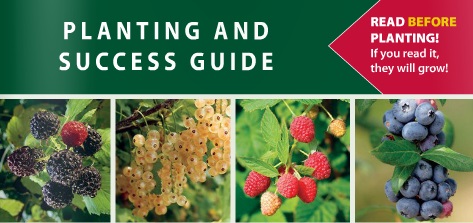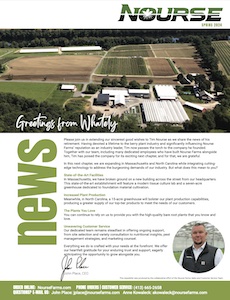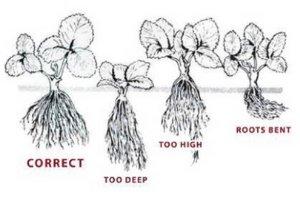In our Fall 2017 Newsletter, we introduced the 5 Points to Ponder for 2018. Now it’s time to prepare!
1) SCOUTING STRATEGY
A key component of a successful pest management program is developing a well-orchestrated scouting strategy. As reported in our Fall Newsletter, many growers once again saw crop damage due to FlowerThrip infestations. A scouting strategy to determine their presence during bloom period could have helped growers prevent crop loss from their mass migration. We recommend growers begin to plan a scouting routine that will being the day mulch is removed from the plants. Plan to visit or have your field visited 1 time per week 1 during the entire season. During blossom and fruit set seriously consider scouting twice per week. Have a check list in hand that identifies possible pests so that no pest goes unchecked. For identification, there are variety of excellent tools including free phone apps such as MYIPM -SED and MYIPM-SEP. Another factor to consider for why to scout is the prevention of early frost damage. We have seen instances where growers were caught off guard, not realizing that flower buds had begun to exit the crowns and the first king flowers were killed.
2) BERRIES TO BREWERIES / WINERIES
Profitably growing berries involves not only work done in the field but marketing and distribution. Growers can be challenged in moving all their berries on slower days during the week such as Monday – Thursday and/or during peak harvest levels. A variety of nontraditional outlets for berries have developed recently that can eliminate this problem for some growers. Popular outlets we have seen our local micro or craft breweries, wineries, and restaurants. According to the Brewers Association, there are over 5,200 craft breweries in the U.S., up from just 2,000 in 2013. At Nourse Farms, we have had good success selling raspberries in bulk at a competitive price. To find micro or craft breweries in your area, go to brewersassociation.org which has an excellent search tool for identifying breweries near you. With almost 7,000 wineries, a great resource to identify wineries in your area can be found at wineriesbystate.com. Based in part on the “Farm to Table” idea, a second popular outlet for berries is the restaurant industry. Chefs, particularly in higher end restaurants, have a great appreciation for local berries and are willing to pay a premium particularly for day-neutral strawberries, fall-bearing raspberries and blackberries as well as June-bearing strawberry kingberries. A great way to meet and develop relationships with restaurants is through your local chamber of commerce and business organizations.
3) PROPER STRAWBERRY PLANTING TIPS
The success of planting begins day one with plant delivery, storage and planting. We encourage growers to keep the ship date of their order as “OPEN”. Calling by Wednesday the week before you need the plants allows us time to prepare your shipment and get it to you. Inspecting plants upon arrival is important. If dormant plants are cool or cold, reseal the cartons and story as close to 28°F as possible, not allowing temperature below 27°. Do not add water or soak your plants until you are read to put them in the ground. One of the biggest planting challenges growers face is setting plants at the right level, not J-rooting the plant and ensuring the soil is pressed firmly, but not hard packed around the roots. Growers have found sharing the diagram below with their planting crew to be helpful. Water thoroughly after planting and maintain good moisture throughout the season.

4) SOCIAL MEDIA OPTIONS
After the on-line marketing tips article in the Fall 2017 Facebook 4 Newsletter, we were asked for details on specific social media channels to consider. This is a brief run-down of the currently most popular channels:
FACEBOOK is the biggest social media network on the web, both in terms of recognition and number of users. Facebook is also one of the most versatile allowing you to share important updates, events, photos, videos and can link to websites and web-based newsletters.
TWITTER allows users to share text updates (280 characters or fewer) along with videos, links, images. Tweets can be easily linked to other users by using hashtags and re-tweeting other content. Good way to let followers know picking conditions as well as share recipes and unique use of berries. Instagram used primarily on cell phones, is a great platform for sharing photos and videos with excellent editing capability. There is nothing like visuals of berries in the field or picked at the stand to entice people to come!
YOUTUBE is a video-sharing platform with over a billion users, where people can view, upload, rate, share and comment on content. One popular use may be a variety of cooking, canning and processing videos using berries.
PINTEREST is a visually oriented platform that allows users to save and display content by“pinning” photos and other graphics to digital bulletin boards. LikeYouTube, could be used to highlight different ways to use berries.
SNAPCHAT is another mobile only network (like Instagram) that’s known for its disappearing content. Photos are available for up to 10 seconds at a time and could be another way to highlight current picking conditions. Which to choose? Consider starting with Facebook, add Twitter and expand your channels based on your asking your customers which channels they use.
5) MEASURING IRRIGATION NEEDS
In our Fall Newsletter, we discussed the impact water levels can have on crop yield and size as well as the importance of irrigation. So how does a grower measure and determine the crops specific moisture needs? At the New England Fruit & Vegetable conference,Trevor Hardy outlined how Brookdale Fruit Farm handles this question. At Brookdale, they measure soil moisture and determine their irrigation cycles using tools that measures soil water tension. Soil water tension has to be overcome for the the crop is being grown in rather than 5 plant to move water into its root system. They believe soil water tension is the best method for reading local soil moisture as it pertains to the specific condition that reference points or analytical tools based on regional weather events. For a copy ofTrevor’s presentation and the tools they use, please email Anne Kowaleck akowaleck@noursefarms.com.




